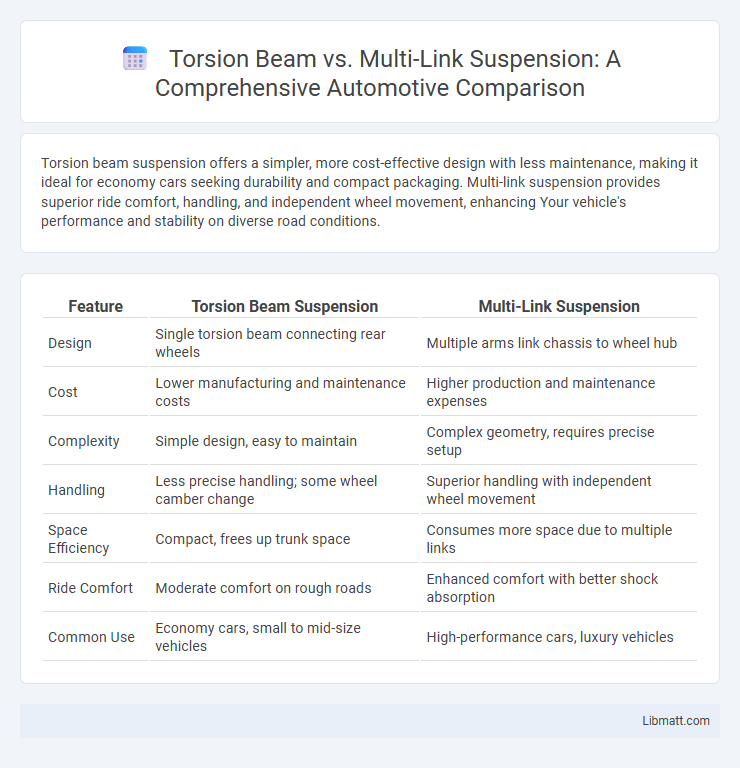Torsion beam suspension offers a simpler, more cost-effective design with less maintenance, making it ideal for economy cars seeking durability and compact packaging. Multi-link suspension provides superior ride comfort, handling, and independent wheel movement, enhancing Your vehicle's performance and stability on diverse road conditions.
Table of Comparison
| Feature | Torsion Beam Suspension | Multi-Link Suspension |
|---|---|---|
| Design | Single torsion beam connecting rear wheels | Multiple arms link chassis to wheel hub |
| Cost | Lower manufacturing and maintenance costs | Higher production and maintenance expenses |
| Complexity | Simple design, easy to maintain | Complex geometry, requires precise setup |
| Handling | Less precise handling; some wheel camber change | Superior handling with independent wheel movement |
| Space Efficiency | Compact, frees up trunk space | Consumes more space due to multiple links |
| Ride Comfort | Moderate comfort on rough roads | Enhanced comfort with better shock absorption |
| Common Use | Economy cars, small to mid-size vehicles | High-performance cars, luxury vehicles |
Introduction to Torsion Beam and Multi-Link Suspensions
Torsion beam suspension is a semi-independent rear suspension system where a single beam acts as both the axle and spring, offering simplicity and cost-effectiveness commonly found in compact cars. Multi-link suspension uses multiple arms and links to control wheel motion, providing superior handling, ride comfort, and better road grip typically used in performance and luxury vehicles. The structural differences impact vehicle dynamics, with torsion beam prioritizing durability and space efficiency, while multi-link emphasizes precise wheel alignment and adaptability to varied driving conditions.
Basic Design and Functionality
The torsion beam suspension features a simple, lightweight design where a single beam connects the rear wheels, allowing limited independent movement primarily through twisting action. In contrast, multi-link suspension comprises multiple arms and joints, providing greater wheel independence and precise handling by controlling wheel alignment in multiple directions. This fundamental difference affects ride comfort and performance, with torsion beams favoring cost-efficiency and space, while multi-link systems enhance handling and road adaptability.
Performance and Handling Differences
Torsion beam suspension systems offer simpler construction and cost efficiency but typically provide less precise handling and reduced wheel independence compared to multi-link setups. Multi-link suspensions enhance performance by allowing better adjustment of wheel angles, improving grip, stability, and responsiveness during cornering and uneven surfaces. Your driving experience benefits from multi-link's superior handling dynamics, especially in high-performance or sporty vehicles.
Ride Comfort and Noise Levels
Multi-link suspension systems offer superior ride comfort by allowing individual wheel movement, reducing road vibrations and improving handling on uneven surfaces. Torsion beam setups, while more cost-effective and space-efficient, tend to transmit more road noise and vibrations into the cabin due to their simpler design and fewer pivot points. Noise levels inside vehicles with multi-link suspension are generally lower, contributing to a quieter and more refined driving experience compared to torsion beam configurations.
Space Efficiency and Packaging
Torsion beam suspensions offer superior space efficiency and simpler packaging due to their compact, integrated design, which allows for more interior cargo volume and easier underbody installation in front- or rear-wheel drive vehicles. Multi-link suspensions, while providing enhanced ride quality and handling, require more complex geometry and additional components, resulting in larger installation space and increased packaging constraints within the vehicle chassis. The choice between torsion beam and multi-link systems impacts overall vehicle layout, weight distribution, and interior space optimization in automotive design.
Cost of Manufacturing and Maintenance
Torsion beam suspensions are generally more cost-effective to manufacture due to their simpler design, requiring fewer components and less material, which also reduces assembly time. This simplicity translates into lower maintenance costs since there are fewer parts subject to wear and failure compared to multi-link suspensions. On the other hand, multi-link systems, while more expensive to produce and maintain because of their complex geometry and numerous bushings, offer superior handling and ride comfort, justifying the higher long-term investment in performance-oriented vehicles.
Suitability for Different Vehicle Types
Torsion beam suspension is typically suited for compact cars and economy vehicles due to its cost-effectiveness, simpler design, and space efficiency, making it ideal for city driving and light loads. Multi-link suspension offers superior handling and comfort, making it more appropriate for luxury sedans, sports cars, and SUVs where performance and ride quality are prioritized. Choosing the right suspension for your vehicle depends on the balance you need between cost, ride comfort, and handling precision.
Durability and Longevity
Torsion beam suspensions offer greater durability due to their simpler design with fewer moving parts, reducing wear and maintenance needs over time, making them ideal for long-term use in budget and compact vehicles. Multi-link suspensions, while providing superior handling and ride quality, contain multiple joints and bushings that can wear out more quickly, potentially leading to higher maintenance costs and shorter component lifespan. The robust construction of torsion beams generally ensures longer-lasting performance under harsh conditions and heavy usage.
Common Applications in Modern Cars
Torsion beam suspensions are commonly found in compact and economy cars due to their simplicity, low cost, and space-saving design that offers adequate handling for everyday driving. Multi-link suspensions are preferred in performance vehicles, SUVs, and luxury cars because they provide superior ride comfort, better handling, and greater adjustability. Your choice between the two affects vehicle dynamics and may influence maintenance complexity and overall driving experience.
Summary: Choosing Between Torsion Beam and Multi-Link
Torsion beam suspension offers a cost-effective, space-saving solution ideal for compact cars, providing stable handling but limited independent wheel movement. Multi-link suspension delivers superior ride comfort and enhanced road grip by allowing each wheel to move independently, commonly preferred in performance and luxury vehicles. The choice between torsion beam and multi-link depends on balancing budget constraints, vehicle type, and desired driving dynamics.
torsion beam vs multi-link Infographic

 libmatt.com
libmatt.com